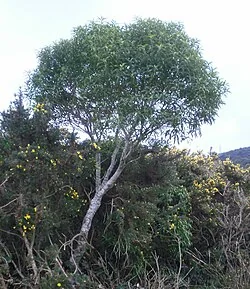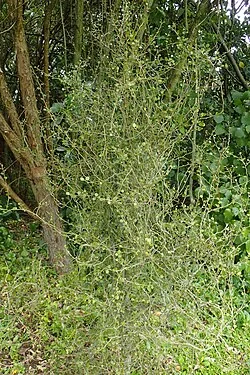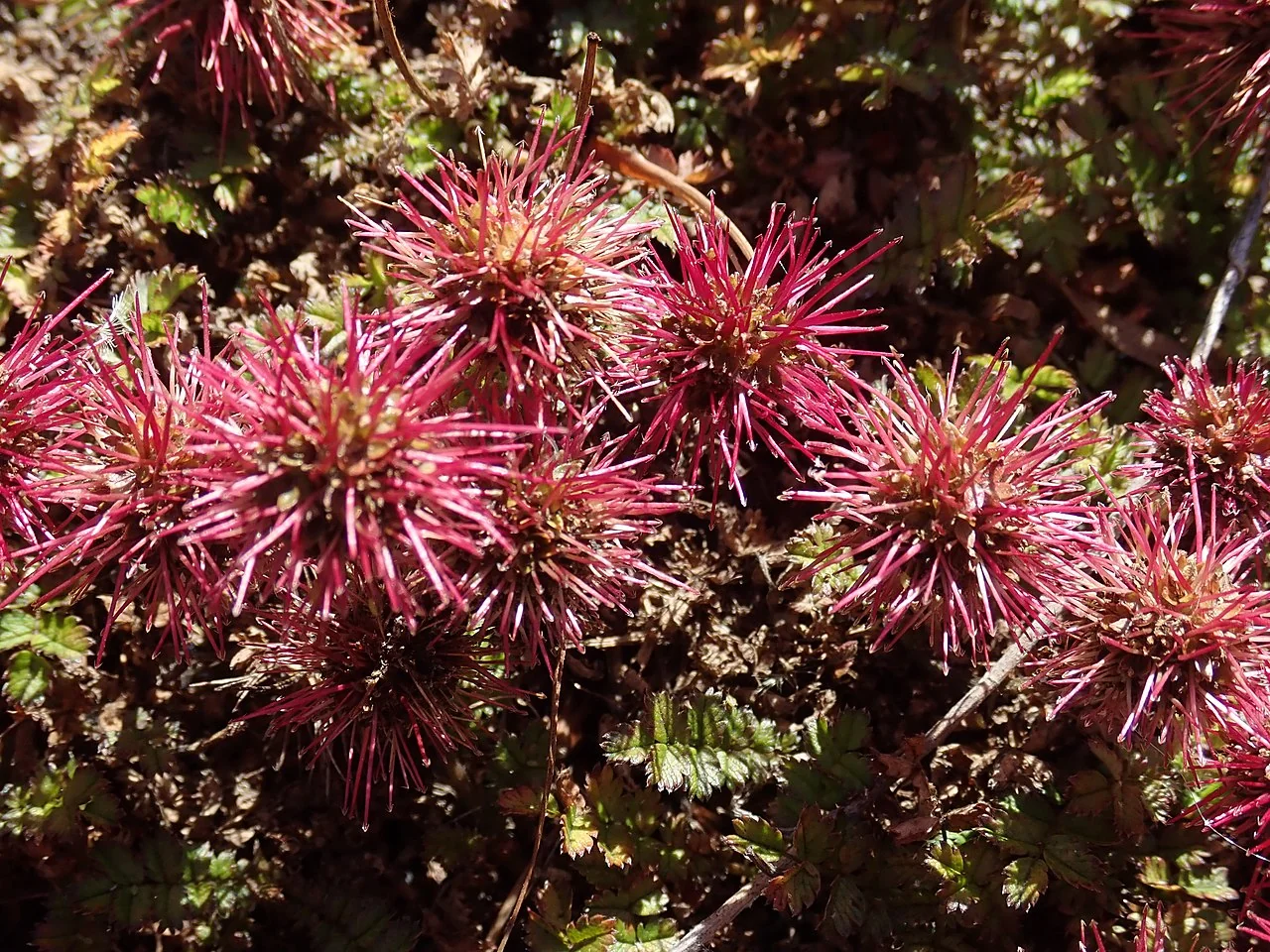
Narrow-Leaved Māhoe
Melicytus lanceolatus
Narrow-leaved Māhoe ( Melicytus lanceolatus ) is a distinctive native New Zealand shrub or small tree, celebrated for its long, narrow, often toothed leaves and its graceful, upright growth habit. This endemic species is typically found in lowland and montane forests throughout New Zealand. Its delicate, greenish-yellow flowers, often hidden beneath the foliage, are followed by small, dark purple berries that are a food source for native birds. Narrow-leaved Māhoe is a resilient and aesthetically pleasing plant that adds unique texture and character to native plant gardens, providing year-round interest and showcasing the diversity of New Zealand's forest understorey. For related species, see the native plants index .

Plant Description
Botanical Features
Narrow-leaved Māhoe ( Melicytus lanceolatus ) is a slender, erect, small tree endemic to New Zealand, growing up to 5-6 meters tall. Its bark is brownish-grey, brown to white, slightly wrinkled, and features prominent lenticels. Its vibrant green leaves are long, thin, and narrow (lanceolate in shape), typically measuring 5-16 cm long by 0.5-2 cm wide, with a finely serrated margin, sometimes curving downwards, giving them a willow-like appearance. The plant produces small, fragrant flowers, about 5 mm in diameter, which occur in clusters of two to six along bare branches or occasionally from leaf axils. These flowers can appear yellow, dark purple, or a combination of both. Following flowering, it produces dark purple, subglobose berries, 4-6 mm in diameter, containing 6-12 minutely tuberculate seeds. It prefers moist, cool areas with high rainfall, thriving in lowland to montane forests.
Quick Facts
Shrub Summary
| Scientific Name | Melicytus Lanceolatus |
|---|---|
| Common Name | Narrow-leaved Māhoe |
| Family | Violaceae |
| Height | Up to 6 m |
| Spread | Up to 3 m |
| Light | Partial shade to full shade |
| Soil | Moist, well-drained, fertile soils |
| Water Needs | Moderate |
| Frost Tolerance | Moderate |
| Salt Tolerance | Low |
| Growth Rate | Medium |
| Lifespan | Medium to Long |
Climate Best Suited to
Regional Suitability
Narrow-leaved Māhoe ( Melicytus lanceolatus ) is native to New Zealand, typically found in lowland and montane forests. It thrives in mild, temperate climates with high humidity and consistent rainfall. It prefers sheltered locations, protected from strong winds and harsh frosts. Its natural habitat includes forest understories and damp gullies, indicating a preference for cooler, shadier conditions. It can be successfully cultivated in similar temperate regions, provided it has good drainage and protection from extreme heat or prolonged severe frosts when young.
| Whangārei | Ideal |
| Auckland | Ideal |
| Hamilton | Suitable |
| Rotorua | Suitable |
| Tauranga | Ideal |
| Gisborne | Ideal |
| New Plymouth | Ideal |
| Whanganui | Ideal |
| Palmerston North | Suitable |
| Napier | Ideal |
| Wellington | Ideal |
| Nelson | Ideal |
| Christchurch | Suitable |
| Dunedin | Suitable |
| Invercargill | Suitable |
| City | Climate Suitability |
|---|
Natural Habitat
Forest Distribution
Understand the natural habitat of Narrow-leaved Māhoe ( Melicytus lanceolatus ), which is found throughout New Zealand, in lowland and montane forests. This section details its geographical distribution, preferred environmental conditions, and the types of ecosystems where it naturally occurs.
- Widespread across New Zealand, from sea level to moderate altitudes.
- Found in lowland and montane forests, often in damp gullies and understories.
- Prefers sheltered sites with good air circulation.
- Thrives in partial to full shade.
Its broad habitat range highlights its adaptability and resilience, making it a fascinating subject for ecological study.
Plant Conservation
Melicytus lanceolatus , commonly known as narrow-leaved Māhoe or Māhoe-wao, is a small tree endemic to New Zealand. Its current conservation status, as of 2023, is classified as "Not Threatened" under the New Zealand Threat Classification System (NZTCS). However, it is also categorized as "At Risk - Naturally Uncommon" due to habitat loss and its naturally restricted distribution. While not considered threatened overall, Melicytus lanceolatus faces challenges from browsing by introduced mammalian species, such as red deer, fallow deer, white-tailed deer, and feral goats, which consume its foliage. Competition from invasive weeds and general habitat loss also pose ongoing issues. This species plays a vital ecological role in New Zealand's native forests, serving as a food source for native birds and supporting diverse communities of forest invertebrates. It is found across the North Island, South Island, and Stewart Island, typically in moist, cool areas with high rainfall, from sea level up to 915 meters. The plant is increasingly valued in native gardens and restoration projects due to its elegant form and moderate growth habit.
Growing Requirements
Soil Requirements
Narrow-leaved Māhoe prefers moist, well-drained, and fertile soils. It naturally grows in humus-rich forest soils. Amend heavy soils with compost or other organic matter to improve drainage and fertility. A neutral to slightly acidic pH is ideal. Ensure consistent moisture, especially during dry periods.
- Prefers moist, well-drained, fertile soils.
- Benefits from organic matter enrichment.
- Ideal pH: neutral to slightly acidic.
- Avoid waterlogged conditions.
Light Requirements
Narrow-leaved Māhoe thrives in partial to full shade, especially when young. It is sensitive to direct, harsh sunlight, which can scorch its leaves. Plant it in a sheltered spot under larger trees or on the shaded side of a building where it receives dappled light or indirect sun throughout the day. Mature trees can tolerate more sun if kept moist.
- Prefers partial to full shade, especially when young.
- Avoid direct, harsh sunlight.
- Ideal for underplanting or sheltered positions.
Water Requirements
This plant requires consistent moisture, especially during dry periods and its establishment phase. The soil should be kept moist but not waterlogged. Regular watering is crucial for healthy growth and abundant fruiting. Reduce watering slightly during cooler winter months.
- Requires consistent moisture.
- Keep soil moist, but ensure good drainage.
- Water more frequently during dry spells.
Planting Guide
Best Time to Plant
The best time to plant Narrow-leaved Māhoe is during autumn or spring, when temperatures are mild and rainfall is more consistent. This allows the plant to establish its root system before the extremes of summer heat or winter cold.
Choosing a Location
Select a site with partial to full shade and moist, well-drained, fertile soil. Narrow-leaved Māhoe is ideal for planting in the understorey of larger trees, in sheltered garden beds, or as a specimen shrub in a protected location. Ensure it has adequate space for its mature size.
Planting Steps
- Dig a hole twice the width of the root ball and the same depth.
- Gently remove the plant from its container, being careful not to disturb the roots.
- Place the plant in the hole, ensuring the top of the root ball is level with the surrounding soil.
- Backfill with amended soil, firming gently around the base of the plant.
- Water thoroughly immediately after planting to settle the soil.
- Apply a layer of organic mulch to help retain moisture and suppress weeds, keeping it away from the stem.
Initial Care
Water regularly during the first 6-12 months to help establish a strong root system. Once established, Narrow-leaved Māhoe is reasonably low maintenance and requires less frequent watering. Protect young plants from strong winds and severe frosts if necessary.
Ecological Role
Forest Ecosystem Importance
The ecological importance of Narrow-leaved Māhoe ( Melicytus lanceolatus ) within its native New Zealand ecosystems is significant. Its berries provide a food source for native birds, and its dense foliage provides shelter for small birds and invertebrates, contributing to the local food web and biodiversity of its varied habitats.
- Berries are a food source for native birds.
- Provides shelter for small birds and invertebrates.
- Contributes to biodiversity in diverse forest ecosystems.
As an endemic species, it is an integral part of the unique biodiversity that has evolved in New Zealand, supporting the delicate balance of its natural habitats.
Uses and Significance
Garden Uses
- Excellent specimen shrub or small tree for native gardens.
- Suitable for underplanting in forest gardens or shaded borders.
- Provides year-round interest with evergreen leaves.
- Attracts native birds to its berries.
Cultural Significance
Traditional Uses and Values
Melicytus lanceolatus , also known as narrow-leaved Māhoe or Māhoe-wao, holds cultural significance primarily within Māori traditions in New Zealand. Its cultural importance stems from its various traditional uses and recognition:
- Traditional Medicine (Rongoā Māori): The bark and leaves of Melicytus lanceolatus were utilized in traditional Māori medicine to address minor ailments.
- Timber Use: Its light and soft wood was employed for temporary construction and crafting implements, similar to how Whiteywood was used.
- Food Source: While not a primary food source, the small berries of the plant were occasionally consumed during travel.
- Environmental Indicator: The presence of Melicytus lanceolatus was recognized as an indicator of suitable growing conditions for other food plants.
- Cultural Recognition and Aesthetics: Traditional Māori knowledge holders distinguished this plant from Whiteywood due to its elegant form. It is valued for its graceful appearance and is often associated with forest margins and protected valleys.
- Indigenous Naming: One of its indigenous names, "Kaiwētā," translates to "wētā food." This name suggests an association with wētā (tree wētā) living in holes within the tree, giving the impression that the wētā consume the plant.
Landscaping Applications
Garden Design Uses
Narrow-leaved Māhoe ( Melicytus lanceolatus ) is a highly attractive and versatile plant for various landscaping applications, particularly in native and shaded gardens. Its graceful form and unique foliage make it a valuable asset.
- Ideal as a specimen shrub or small tree for larger gardens and parks.
- Excellent for native forest restoration and revegetation projects.
- Provides year-round interest with evergreen leaves.
- Suitable for mass plantings or as an accent plant.
Its ability to thrive in sheltered, shaded conditions and its aesthetic appeal make it a popular choice for creating lush and beautiful native landscapes.
Seasonal Care Calendar
Spring
New growth emerges, and delicate greenish-yellow flowers may appear. This is an ideal time for planting new Narrow-leaved Māhoe specimens or propagating from cuttings. Ensure consistent moisture for young plants and protect them from strong winds if necessary. A light feed with a balanced slow-release fertilizer can encourage vigorous growth.
- Ideal time for planting and propagation.
- Ensure consistent moisture for new plants.
- Light fertilization if needed.
Summer
Narrow-leaved Māhoe is actively growing and flowering during summer, followed by the development of berries. Consistent watering is crucial, especially during dry spells, to prevent stress. Monitor for pests and diseases, though it is generally quite resilient.
- Active growth and flowering.
- Consistent watering is essential.
- Monitor for pests and diseases.
Autumn
Berries ripen and become prominent in autumn, providing a valuable food source for native birds. This is another good time for planting, allowing roots to establish before winter. Minimal care is required for established plants, but ensure they remain adequately hydrated.
- Berries ripen, attracting birds.
- Good time for planting.
- Ensure adequate hydration.
Winter
Narrow-leaved Māhoe is evergreen and provides year-round interest. It is moderately frost-tolerant, but in very cold regions, young plants may benefit from some protection. Ensure good drainage to prevent root issues in wet conditions.
- Evergreen, provides year-round interest.
- Protect young plants from severe frost.
- Ensure good drainage.
When to Prune and How Much
Light Pruning
Narrow-leaved Māhoe generally requires minimal pruning to maintain its natural form. The primary reason for pruning is to remove dead or damaged branches, or to shape the plant as desired. Its natural growth habit is often quite attractive, so extensive pruning is rarely needed.
- Remove dead or damaged branches as needed.
- Light shaping to maintain desired form.
- Best done in late winter or early spring before new growth.
- Use clean, sharp tools.
Avoid heavy pruning, as this can stress the plant. Allow it to develop its natural, graceful canopy.
How to Grow Narrow-Leaved Māhoe
Narrow-leaved Māhoe is a distinctive native New Zealand shrub or small tree, celebrated for its long, narrow, often toothed leaves and its graceful, upright growth habit. This endemic species is typically found in lowland and montane forests throughout New Zealand. Its delicate, greenish-yellow flowers, often hidden beneath the foliage, are followed by small, dark purple berries that are a food source for native birds. Narrow-leaved Māhoe is a resilient and aesthetically pleasing plant that adds unique texture and character to native plant gardens, providing year-round interest and showcasing the diversity of New Zealand's forest understorey. Understanding its propagation methods is key to successfully growing this delightful species.
From Seed
Propagating Narrow-leaved Māhoe from fresh seed is a viable method, though germination can be slow and may require stratification. Collect ripe berries in late autumn or early winter. Clean the seeds thoroughly to remove any fleshy pulp. Sow the seeds in a tray filled with a well-draining seed-raising mix, lightly covering them. The seeds typically require a period of cold stratification (e.g., refrigerate for 2-3 months) to break dormancy. Maintain consistent moisture in the seed tray and keep it in a warm, sheltered location. Germination can take several weeks to months after stratification. Once seedlings have developed a few true leaves, they can be potted into individual containers and grown in a sheltered environment before planting out.
From Cuttings
Semi-hardwood cuttings are a reliable method for propagating Narrow-leaved Māhoe, ensuring that new plants retain the exact characteristics of the parent. Take 10-15 cm cuttings from healthy, semi-hardwood stems in late summer or early autumn. Remove the lower leaves and dip the cut end in a rooting hormone. Insert the cuttings into a well-draining propagation mix (e.g., sand and perlite). Keep the cuttings in a warm, humid environment, out of direct sunlight, perhaps under a plastic dome or in a propagator. Rooting typically occurs within 8-12 weeks. Once rooted, the new plants can be potted on and grown in a sheltered environment until they are ready for planting.
Pests and Diseases
Narrow-leaved Māhoe is generally a robust plant, but it can be susceptible to certain pests and diseases, especially if not grown in optimal conditions.
Common Pests
- Aphids: Can infest new growth. Treat with insecticidal soap or remove manually.
- Scale Insects: May be present on stems and leaves. Treat with horticultural oil or appropriate insecticides.
Common Diseases
- Sooty Mould: Often associated with scale insect infestations, it can cover leaves and reduce photosynthesis. Address the underlying pest issue.
- Root Rot: Caused by overwatering or poor drainage. Ensure well-drained soil.
Good garden hygiene, proper watering, and adequate air circulation are key to preventing most pest and disease issues. Regular inspection will help catch problems early.
Bonus Tip
Expert Growing Advice
The dark purple berries of the Narrow-leaved Māhoe are not just a favourite of native birds, they can also stain your hands purple if you handle them!







